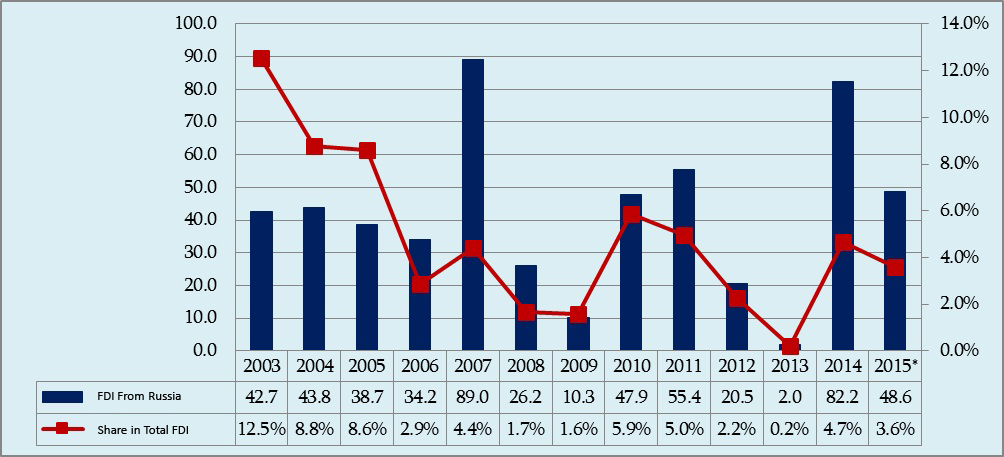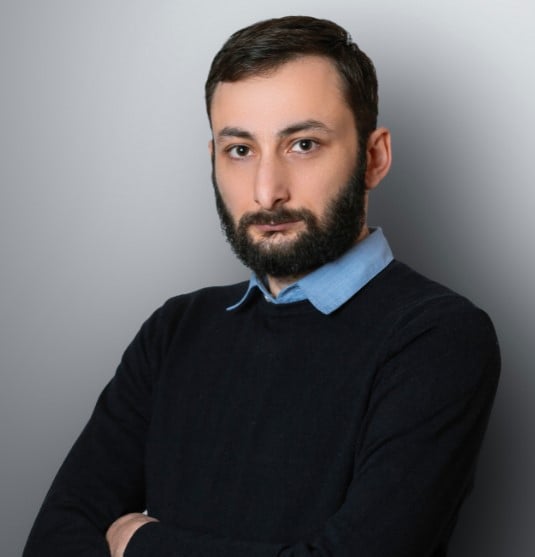The Prime Minister of Georgia, Giorgi Kvirikashvili, as a reply to a question raised at one of the international energy forums, stated that: "Russian investments to Georgia used to flow in larger volumes under the previous government than under the incumbent one."
FactCheck took interest in the accuracy of the statement.
Foreign direct investments (FDI) are considered to be one of the major factors contributing to economic development. At the same time, investments create inflows of foreign currencies which enhance the stability of the national currency. Naturally, the growth in foreign direct investments is indeed a positive event. However, considering the political agenda and the national interests of a nation, investments from certain foreign countries into different sectors of a recipient country’s economy might bear some risks and be considered as contradictory to national interests. In the case of Georgia, this issue is a wide topic of discussion. Therefore, given the limitations of this article, FactCheck will not engage in this discussion and analyse the existing statistical data alone.
Graph 1: Foreign Direct Investments from Russia (USD Million)
 Source: National Statistics Office of Georgia
Graph 1 illustrates the volume of foreign direct investments made from Russia to Georgia in the period of 2003-2015 and its share in the total amount of FDI. The maximum volume of investments from Russia in absolute numbers was registered in 2007, reaching USD 89 million. Close behind, USD 82.2 million was registered in 2014. The volume of Russian investments in other years lags far behind these two numbers. The least amount of Russian investments was registered in 2013 and amounted to a meagre USD 2 million. The amount of Russian investments in 2008 and 2009 was also low. The world financial crisis of 2008-2009, naturally, influenced the decrease in investments which was characteristic for the entire world economy at that time. In regard to average numbers, the average amount of investments in 2013-2015 was USD 44.3 million whilst this number was USD 40.7 million in the period 2004-2012. The average amount of Russian investments in the post-war period (2009-2012) was USD 33.5 million. At the same time, if we compare any three-year period between 2004 and 2012 to the period of 2013-2015, we will see that not a single three-year period exceeds the 2013-2015 period in terms of Russian investments in Georgia.
If we analyse the share of Russian investments in the total amount of FDI, we will see that the share of Russian investments dropped considerably (from 12.5% to 1.6%) in the period of 2003-2009. In 2010, this number rose to 5.9% but a tendency of decline became evident in the following years with the share of Russian investments in the total amount of FDI having dropped to 2.2% in 2012. This trend was maintained after the change of government with the share of Russian investments in the total amount of FDI having fell to 0.2% in 2013. In 2014-2015, this number grew by 4.7% and 3.6%, respectively.
Conclusion
The absolute number of Russian investments, together with its share in the total amount of FDI, has been the subject of significant fluctuation since 2004 until the present day. The change of government did not cause an explicit change in this trend. The only visible trend is a significant decline in the share of Russian investments in the period of 2003-2009. The average share of Russian investments in the total amount of FDI in the period of 2004-2012 is 4.6% which in absolute terms is USD 40.7 million. Similar numbers for the period of 2013-2015 are 2.8% and USD 44.3 million, respectively.
FactCheck leaves Giorgi Kvirikashvili’s statement WITHOUT VERDICT.
Source: National Statistics Office of Georgia
Graph 1 illustrates the volume of foreign direct investments made from Russia to Georgia in the period of 2003-2015 and its share in the total amount of FDI. The maximum volume of investments from Russia in absolute numbers was registered in 2007, reaching USD 89 million. Close behind, USD 82.2 million was registered in 2014. The volume of Russian investments in other years lags far behind these two numbers. The least amount of Russian investments was registered in 2013 and amounted to a meagre USD 2 million. The amount of Russian investments in 2008 and 2009 was also low. The world financial crisis of 2008-2009, naturally, influenced the decrease in investments which was characteristic for the entire world economy at that time. In regard to average numbers, the average amount of investments in 2013-2015 was USD 44.3 million whilst this number was USD 40.7 million in the period 2004-2012. The average amount of Russian investments in the post-war period (2009-2012) was USD 33.5 million. At the same time, if we compare any three-year period between 2004 and 2012 to the period of 2013-2015, we will see that not a single three-year period exceeds the 2013-2015 period in terms of Russian investments in Georgia.
If we analyse the share of Russian investments in the total amount of FDI, we will see that the share of Russian investments dropped considerably (from 12.5% to 1.6%) in the period of 2003-2009. In 2010, this number rose to 5.9% but a tendency of decline became evident in the following years with the share of Russian investments in the total amount of FDI having dropped to 2.2% in 2012. This trend was maintained after the change of government with the share of Russian investments in the total amount of FDI having fell to 0.2% in 2013. In 2014-2015, this number grew by 4.7% and 3.6%, respectively.
Conclusion
The absolute number of Russian investments, together with its share in the total amount of FDI, has been the subject of significant fluctuation since 2004 until the present day. The change of government did not cause an explicit change in this trend. The only visible trend is a significant decline in the share of Russian investments in the period of 2003-2009. The average share of Russian investments in the total amount of FDI in the period of 2004-2012 is 4.6% which in absolute terms is USD 40.7 million. Similar numbers for the period of 2013-2015 are 2.8% and USD 44.3 million, respectively.
FactCheck leaves Giorgi Kvirikashvili’s statement WITHOUT VERDICT.
 Source: National Statistics Office of Georgia
Graph 1 illustrates the volume of foreign direct investments made from Russia to Georgia in the period of 2003-2015 and its share in the total amount of FDI. The maximum volume of investments from Russia in absolute numbers was registered in 2007, reaching USD 89 million. Close behind, USD 82.2 million was registered in 2014. The volume of Russian investments in other years lags far behind these two numbers. The least amount of Russian investments was registered in 2013 and amounted to a meagre USD 2 million. The amount of Russian investments in 2008 and 2009 was also low. The world financial crisis of 2008-2009, naturally, influenced the decrease in investments which was characteristic for the entire world economy at that time. In regard to average numbers, the average amount of investments in 2013-2015 was USD 44.3 million whilst this number was USD 40.7 million in the period 2004-2012. The average amount of Russian investments in the post-war period (2009-2012) was USD 33.5 million. At the same time, if we compare any three-year period between 2004 and 2012 to the period of 2013-2015, we will see that not a single three-year period exceeds the 2013-2015 period in terms of Russian investments in Georgia.
If we analyse the share of Russian investments in the total amount of FDI, we will see that the share of Russian investments dropped considerably (from 12.5% to 1.6%) in the period of 2003-2009. In 2010, this number rose to 5.9% but a tendency of decline became evident in the following years with the share of Russian investments in the total amount of FDI having dropped to 2.2% in 2012. This trend was maintained after the change of government with the share of Russian investments in the total amount of FDI having fell to 0.2% in 2013. In 2014-2015, this number grew by 4.7% and 3.6%, respectively.
Conclusion
The absolute number of Russian investments, together with its share in the total amount of FDI, has been the subject of significant fluctuation since 2004 until the present day. The change of government did not cause an explicit change in this trend. The only visible trend is a significant decline in the share of Russian investments in the period of 2003-2009. The average share of Russian investments in the total amount of FDI in the period of 2004-2012 is 4.6% which in absolute terms is USD 40.7 million. Similar numbers for the period of 2013-2015 are 2.8% and USD 44.3 million, respectively.
FactCheck leaves Giorgi Kvirikashvili’s statement WITHOUT VERDICT.
Source: National Statistics Office of Georgia
Graph 1 illustrates the volume of foreign direct investments made from Russia to Georgia in the period of 2003-2015 and its share in the total amount of FDI. The maximum volume of investments from Russia in absolute numbers was registered in 2007, reaching USD 89 million. Close behind, USD 82.2 million was registered in 2014. The volume of Russian investments in other years lags far behind these two numbers. The least amount of Russian investments was registered in 2013 and amounted to a meagre USD 2 million. The amount of Russian investments in 2008 and 2009 was also low. The world financial crisis of 2008-2009, naturally, influenced the decrease in investments which was characteristic for the entire world economy at that time. In regard to average numbers, the average amount of investments in 2013-2015 was USD 44.3 million whilst this number was USD 40.7 million in the period 2004-2012. The average amount of Russian investments in the post-war period (2009-2012) was USD 33.5 million. At the same time, if we compare any three-year period between 2004 and 2012 to the period of 2013-2015, we will see that not a single three-year period exceeds the 2013-2015 period in terms of Russian investments in Georgia.
If we analyse the share of Russian investments in the total amount of FDI, we will see that the share of Russian investments dropped considerably (from 12.5% to 1.6%) in the period of 2003-2009. In 2010, this number rose to 5.9% but a tendency of decline became evident in the following years with the share of Russian investments in the total amount of FDI having dropped to 2.2% in 2012. This trend was maintained after the change of government with the share of Russian investments in the total amount of FDI having fell to 0.2% in 2013. In 2014-2015, this number grew by 4.7% and 3.6%, respectively.
Conclusion
The absolute number of Russian investments, together with its share in the total amount of FDI, has been the subject of significant fluctuation since 2004 until the present day. The change of government did not cause an explicit change in this trend. The only visible trend is a significant decline in the share of Russian investments in the period of 2003-2009. The average share of Russian investments in the total amount of FDI in the period of 2004-2012 is 4.6% which in absolute terms is USD 40.7 million. Similar numbers for the period of 2013-2015 are 2.8% and USD 44.3 million, respectively.
FactCheck leaves Giorgi Kvirikashvili’s statement WITHOUT VERDICT.
Tags:







